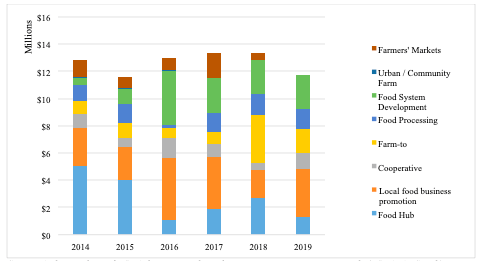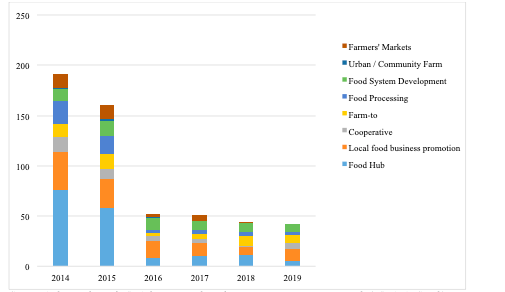Enhancing “Farm-tos” in Northern New Jersey: Policy recommendations
A “Farm-to” is a distribution network which promotes the supply of local and regional agricultural and food products to established businesses and public institutions. While the most common examples of Farm-tos are farm-to-consumer venues such as farmers’ markets, Farm-tos can also include schools, restaurants, grocery or big-box superstores, private company cafeterias, hospitals, and even prisons. Farm-tos empower individual farmers to specialize in products that meet the needs of their business partners and community, while increasing farmer income and, in some cases, eliminating the added expense of the middleman. Farm-tos encourage the development of farm-to-customer business relationships and help farmers make their products available to their local communities, with a mission of inserting local foods directly into the local food system.
New Jersey, my home state, ranks in the top ten nationwide for the production of ten fruit and vegetable crops, and has dedicated 750,000 acres of land to farming. Part of this agricultural success is attributed to efforts made towards the preservation of farm land in tandem with the “Jersey Fresh” marketing campaign pioneered by the state’s Department of Agriculture in 1985 (NJ Department of Agriculture, n.d.). Given the large amount of food grown in the state, New Jersey is well positioned to support thriving Farm-to operations.
Since 2014, more than $75 million has been awarded to support local and regional food programs throughout the U.S. in the form of government grants, with an additional $35 million raised in matching private donations (USDA, AMS, n.d.). Supported programs range from the creation or expansion of farmers’ markets to building processing facilities and entrepreneurial innovation centers for new food businesses. These programs aim to get more locally grown and processed foods to more people in surrounding communities. In comparison to other states, New Jersey has been largely underrepresented in project support, receiving less than 1% of total funding and accounting for only 4 of 540 programs over the six years. While the agricultural industry is strong, this absence of inclusion does not indicate that farmers do not need support to improve participation in their local markets. My research examines current federal funding of farm-to-consumer initiatives in the state and in the U.S., and provides recommendations to expand farmer and local food business outreach to northern New Jersey’s growing urban and suburban communities.
Methods and Findings
Between 2014 and 2019, USDA awarded 540 Local Food Promotion Program (LFPP) grants to projects throughout the U.S. The LFPP provides grant funding for projects which seek to increase availability, access, and consumption of local and regionally grown and processed agricultural products in the U.S. Projects are diverse in scope, and not restricted to farmers’ markets or agricultural institutions; examples include the expansion of local food businesses, shared kitchens or food incubators, business plans, and market research or feasibility studies. The grant award data from the LFPP provides insight into how different localities around the nation support Farm-To operations (USDA, AMS, n.d.).
Using the LFPP grant information available on the USDA website, I created a database that recorded award year, amount received, recipient information, and project location. To help identify trends, I then classified the projects into eight categories: Food Hubs, Local Food Business Promotion, Farm-To, Food Processing, Cooperative, Farmers’ Markets, Urban/Community Farms, and Food System Development.
Although local food business promotion projects have received the most funding overall at 25% and $19 million awarded to provide general business support or expansion, new food product innovation, and marketing or sales support, grant funding and project volume has dramatically evolved since 2014. Between 2014 and 2017, the number of funded projects decreased from 191 to 42 per year, with grant value increasing from an average of $67,040 to $279,747 per grant. Initially, almost 40% of local food movement projects and of total funding focused on the creation or expansion of food hubs. In 2016, project themes shifted from the centralized aggregation and distribution of farm foods to determining ways to increase the amount of all locally farmed food into the supply chain through the promotion of local food businesses and the development of local food systems. By 2017, “Farm-To” projects received the most support with an average of over $350,000 per project to align with the trends of decentralization and individualization of local food systems (USDA, AMS, n.d.).
Chart 1: Local Food Promotion Program Funding: 2014-2019
Source: Author analysis of USDA data on Local Food Promotion Program grant awards (USDA, AMS, n.d.)
Chart 2: Number of Projects by Category and Year
Source: Author analysis of USDA data on Local Food Promotion Program grant awards (USDA, AMS, n.d.)
Discussion and Recommendations for New Jersey
With farms experiencing declining income due to increasing expenses, the continued shift of the consumption of food outside of the home, and the lacking efforts to understand how farms can support New Jersey’s growing population, innovation and support through grant funding is necessary to help support the growth of New Jersey’s agricultural industry (Wolfe 2019). Based on my analysis, the following recommendations would improve the ability of farmers in the state to provide local food to residents.
Farm-To Feasibility Study
To support this effort, additional research is required to evaluate the number of places that can receive local foods in the surrounding communities (schools, hospitals, prisons, local corner stores, etc.) and to mitigate common roadblocks which may prevent the successful relationship including: Creation of food safety and handling protocol and policy to ensure farm foods meet health code standards of public institutions; Reevaluation of food options at restaurants and other institutions and coordination of agricultural products grown to ensure farm foods can be incorporated into menus; Consideration of food transformation and/or light processing (i.e. freezing, canning or jarring) that can be performed on farms so that customers can utilize farm foods year-round and so that “ugly produce” will not be discarded.
Local Community Kitchens for Value-Add Food Products
Currently, New Jersey does not allow individuals to sell food made outside of a certified kitchen. The high cost of commercial kitchen rental facilities serves as a barrier to entry into the food product industry, and limits the types of local food products available. A community kitchen incubator and processing center can help support farmers and food entrepreneurs to create value-added products from local farm inputs that can support farm income and growth throughout the year, and provide jobs as a new business venture in the state.
Local Food Marketing / Business Development Center
A small business development center devoted to outreach and technological assistance can be established to support the expansion of business branches within individual farms and local food businesses. Available services can include: Instructional trainings on data aggregation and analysis for farm input/growth as well as pricing models and income tracking, and online retail sales tools; Marketing of local products through the “Jersey Fresh” program, or help establish relationships between producers and larger grocery stores; Improvement of digital footprint and online presence through social media and interactive websites to better connect to larger audience.
Food Policy Representation on Local Government/Councils
By including a Local Food Policy representative on town and city councils, helps to ensure food interests in the community are met, and to better understand how local food resources can be included in the decision making process when it comes to land transformation, new business proposals, farm-to opportunities. Influence and idea sharing can be both governmental and corporate, helping persuade governments to create new zoning or taxation laws, and banks to issue loans with lower interest rates, mortgage refinancing, or additional financial services for businesses supporting local farms. As a subject matter expert in nutrition support programs and in food safety and distribution requirements for farm food supplied to schools, restaurants, and grocery stores, the Food Policy representative can coordinate efforts to redistribute food direct to consumers for emergency relief. This type of centralized representation could prove critical in the support of food security for citizens in times of crisis, as in COVID-19, and to also reduce the risk of business failure and food waste.
Conclusion
The identification and enhancement of Farm-to relationships in New Jersey can prove critical in the promotion of the farming industry by connecting the state’s rich farming tradition with developing business opportunities and established markets. New Jersey’s $1 billion dollar agricultural industry is strong, but farmers need support in addition to land preservation and marketing tactics to continue to compete against rising costs and changes to consumer preferences. New Jersey farms and businesses must consider projects which support local food and Farm-to networks, take advantage of available federal funding, and tailor solutions utilized by other states to meet New Jersey farm’s and communities’ bespoke needs.
References
New Jersey Department of Agriculture, Marketing and Development. “NJ Farm Facts.” (n.d.). Jersey Fresh. Retrieved from: https://findjerseyfresh.com/facts/statistics/
United States Department of Agriculture, Agricultural Marketing Service. “Local Food Promotion Program.” (n.d.). https://www.ams.usda.gov/services/grants/lfpp
Wolfe, James. “Census of Agriculture Reveals Increase in Number of Farms in New Jersey.” (2019, April 11). State Department of Agriculture. Retrieved from: https://www.nj.gov/agriculture/news/press/2019/approved/press190411.html


